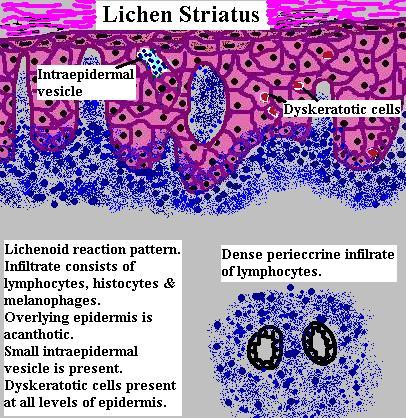Lichen striatus
Salient features
·
An asymptomatic, linear dermatosis that primarily affects
children
·
The primary lesion is a small, flat-topped papule that ranges in
color from pink to skin-colored to tan (hypo pigmented)
·
Multiple lesions appear over the course of days to weeks along
the lines of Blaschko and usually on an extremity
·
Spontaneously resolves over months to a few years
·
Digital involvement may result in nail dystrophy
Introduction
Lichen
striatus is an asymptomatic, self-limited, linear inflammatory dermatosis of unknown etiology
that generally affects children. The diagnosis is usually made clinically based
upon the appearance of the primary lesions and the distinctive developmental
pattern. Its distribution along Blaschko's
lines plus the age of the patient usually narrows the differential diagnosis
rather quickly.
Epidemiology
Lichen
striatus is seen primarily in children between the ages of 4 months and 15
years, although the disorder occasionally occurs in adults. The median age of
onset is 2 to 3 years and the vast majority of cases occur in preschool-age
children. Females
are affected approximately two to three times as frequently as males.
Environmental
factors
Possible triggering factors include viral infection and
trauma in genetically predisposed individuals. The role of viruses has
been suggested by the predominance of the disorder in young children and its
seasonal variation (it appears more commonly during spring and summer).
Lichen striatus may represent a
manifestation of an atopic diathesis in about 40% of patients.
Clinical features
The initial presentation is characterized by the sudden
appearance of small, discrete, pink, flat‐topped, lichenoid papules in a typical linear distribution.
The lesions extend over the course of a week or more and rapidly coalesce to
form linear band, continuous or interrupted, usually 2 mm to 2 cm in width, and
often irregular. Occasionally, the bands broaden into plaques, especially on
the buttocks. The lesion may be only a few centimeters in length or may extend
the entire length of the limb. Typically, there is a single, unilateral streak
on an extremity along Blaschko's lines; occasionally, there is a bilateral
distribution pattern and/or multiple parallel bands.
The lesions occur most
commonly on one arm or leg with limbs are affected in more than over 75%
patients. The abdomen, buttocks and thighs may be involved in single extensive
lesions.
It is uncommon for lichen striatus to involve the trunk or
head and neck region. There are reports of the eruption spreading distally from
the trunk down an extremity, as well as proximal extension along an extremity.
The initial lichenoid papules are pink, not violaceous, and
show no Wickham’s striae. The papules may be hypo pigmented in dark‐skinned people.
Involvement
of the nails may result in longitudinal ridging, splitting, onycholysis or
total nail loss.
Disease course and prognosis
Spontaneous resolution can be
expected within 6–12 months in most cases, leaving post inflammatory hypo
pigmentation, particularly in those with more darkly pigmented skin and persist
for longer. In the latter individuals, the eruption is often first noticed as
linear hypopigmentation. It
may follow a prolonged and/or relapsing course, particularly in adults. Lichen
striatus presenting in adults tends to be more extensive and symptomatic and
may require treatment.
Histopathology
The histologic features of lichen
striatus varies and depend upon the age of the lesion at the time the biopsy is
performed. In addition, different sites within the same streak can have
different findings. In general, there is a lichenoid tissue reaction in
addition to varying degrees of involvement of the hair follicles and ecrine sweat
glands and ducts. Even though the lichenoid inflammation that may be present
around hair follicles is indistinguishable from that seen in lichen
planopilaris, involvement of the sweat gland can still be a helpful diagnostic
feature of lichen striatus. Dyskeratotic keratinocytes, are seen in about 50% of
cases.
Differential Diagnosis
A variant of blaschkitis that
occurs in adults is referred to as adult blaschkitis, acquired self-healing
blaschko dermatitis.
Characterized by papulovesicles
grouped in multiple ipsilateral blaschkoid bands, adult blaschkitis typically
affects the trunk. It resolves rapidly without sequelae, but relapses are
frequent. Histopathology reveals a predominance of spongiotic dermatitis.
Although
linear LP and lichen striatus can occasionally be indistinguishable
histologically, the primary lesions usually differ in size and color, and
hypopigmentation is a frequent sequela of lichen striatus, while, in general,
hyperpigmentation appears in the wake of LP. In lichen
nitidus, linear lesions reflect previous traumatic injury to the skin.
Differential Diagnosis between Blaschkitis and Lichen
Striatus
Treatment
Usually no treatment is necessary in
childhood cases which are largely asymptomatic and typically spontaneously
resolve. In patients with troublesome itch (usually adults), topical
corticosteroids are the first line of treatment. However, in resistant cases
or when there are concerns over topical corticosteroid‐induced skin atrophy, calcineurin inhibitors may be
considered. Nail involvement may respond to potent steroid cream under
occlusion.
Therapeutic ladder
First line
·
Observation and reassurance
·
Topical corticosteroids
Second line
·
Topical tacrolimus
·
Topical pimecrolimus



